A) The multilateral approach has the potential to result in freer trade than does the unilateral approach.
B) The multilateral approach may have a political advantage over the unilateral approach.
C) The multilateral approach is simpler than the unilateral approach.
D) NAFTA and GATT both represent multilateral approaches to free trade.
F) B) and D)
Correct Answer

verified
Correct Answer
verified
True/False
If a country allows free trade and its domestic price for a given good is lower than the world price, then it will import that good.
B) False
Correct Answer

verified
Correct Answer
verified
Multiple Choice
Figure 9-15 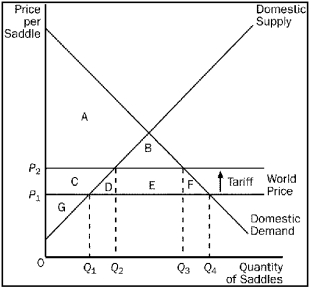 -Refer to Figure 9-15. As a result of the tariff, there is a deadweight loss that amounts to
-Refer to Figure 9-15. As a result of the tariff, there is a deadweight loss that amounts to
A) B.
B) E.
C) D + F.
D) B + D + E + F.
F) A) and C)
Correct Answer

verified
Correct Answer
verified
Multiple Choice
When a nation first begins to trade with other countries and the nation becomes an importer of corn,
A) this is an indication that the world price of corn exceeds the nation's domestic price of corn in the absence of trade.
B) this is an indication that the nation has a comparative advantage in producing corn.
C) the nation's consumers of corn become better off and the nation's producers of corn become worse off.
D) All of the above are correct.
F) A) and C)
Correct Answer

verified
Correct Answer
verified
Multiple Choice
Which of the following is the most accurate statement?
A) The one argument for restricting trade that almost all economists accept as valid is the infant-industry argument.
B) Almost all economists insist that it is never appropriate to protect "key" industries, even when there are legitimate concerns about national security.
C) The idea that one nation might want to threaten another nation with a trade restriction is associated with the protection-as-a-bargaining-chip argument for restricting trade.
D) The protection-as-a-bargaining-chip argument for restricting trade is also known as the infant-industry argument.
F) C) and D)
Correct Answer

verified
Correct Answer
verified
Multiple Choice
Denmark is an importer of computer chips, taking the world price of $12 per chip as given. Suppose Denmark imposes a $5 tariff on chips. Which of the following outcomes is possible?
A) More Danish-produced chips are sold in Denmark.
B) More foreign-produced chips are sold in Denmark.
C) Danish consumers of chips become better off.
D) Total surplus in the Danish chip market increases.
F) A) and B)
Correct Answer

verified
Correct Answer
verified
True/False
Free trade allows firms to realize economies of scale, resulting in higher costs of production.
B) False
Correct Answer

verified
Correct Answer
verified
Multiple Choice
Figure 9-10. The figure applies to Mexico and the good is rifles. 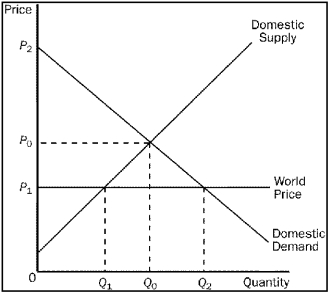 -Refer to Figure 9-10. The area bounded by the points (Q0, P0) , (Q2, P1) , and (Q1, P1) represents
-Refer to Figure 9-10. The area bounded by the points (Q0, P0) , (Q2, P1) , and (Q1, P1) represents
A) Mexico's gains from trade.
B) the amount by which Mexico's gain in producer surplus exceeds its loss in consumer surplus due to trade.
C) Mexico's loss in total surplus due to trade.
D) All of the above are correct.
F) C) and D)
Correct Answer

verified
Correct Answer
verified
True/False
Most economists support the infant-industry argument because it is so easy to implement in practice.
B) False
Correct Answer

verified
Correct Answer
verified
Multiple Choice
Figure 9-5 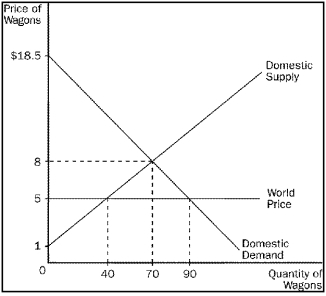 -Refer to Figure 9-5. The horizontal line at the world price of wagons represents the
-Refer to Figure 9-5. The horizontal line at the world price of wagons represents the
A) demand for wagons from the rest of the world.
B) supply of wagons from the rest of the world.
C) level of inefficiency in the domestic market caused by trade.
D) surplus in the domestic wagon market.
F) A) and D)
Correct Answer

verified
Correct Answer
verified
Multiple Choice
Figure 9-3. The domestic country is China. 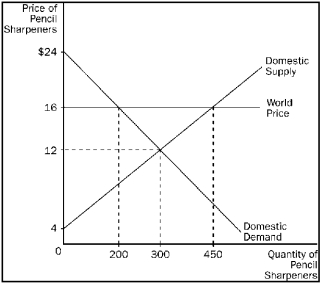 -Refer to Figure 9-3. With trade, China will
-Refer to Figure 9-3. With trade, China will
A) import 100 pencil sharpeners.
B) import 250 pencil sharpeners.
C) export 150 pencil sharpeners.
D) export 250 pencil sharpeners.
F) A) and B)
Correct Answer

verified
Correct Answer
verified
Multiple Choice
Scenario 9-2 For a small country called Boxland, the equation of the domestic demand curve for cardboard is , where represents the domestic quantity of cardboard demanded, in tons, and represents the price of a ton of cardboard.For Boxland, the equation of the domestic supply curve for cardboard is , where represents the domestic quantity of cardboard supplied, in tons, and again represents the price of a ton of cardboard. -Refer to Scenario 9-2. Suppose the world price of cardboard is $45. Then, if Boxland goes from prohibiting international trade in cardboard to allowing international trade in cardboard,
A) domestic producers of cardboard become better off and domestic consumers of cardboard become better off.
B) domestic producers of cardboard become better off and domestic consumers of cardboard become worse off.
C) domestic producers of cardboard become worse off and domestic consumers of cardboard become better off.
D) domestic producers of cardboard become worse off and domestic consumers of cardboard become worse off.
F) A) and B)
Correct Answer

verified
Correct Answer
verified
Multiple Choice
Figure 9-2 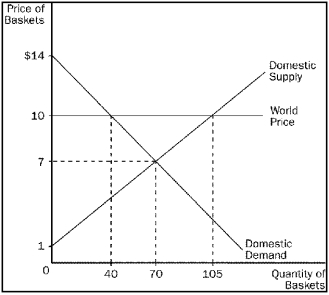 -Refer to Figure 9-2. With free trade, consumer surplus is
-Refer to Figure 9-2. With free trade, consumer surplus is
A) $45.
B) $80.
C) $210.
D) $245.
F) A) and C)
Correct Answer

verified
Correct Answer
verified
True/False
For Country A, the world price of textiles exceeds the domestic equilibrium price of textiles. As a result, international trade allows sellers of textiles in Country A to experience greater producer surplus than they otherwise would experience.
B) False
Correct Answer

verified
Correct Answer
verified
Multiple Choice
A tariff is a
A) limit on how much of a good can be exported.
B) limit on how much of a good can be imported.
C) tax on an exported good.
D) tax on an imported good.
F) B) and D)
Correct Answer

verified
Correct Answer
verified
Multiple Choice
Figure 9-17 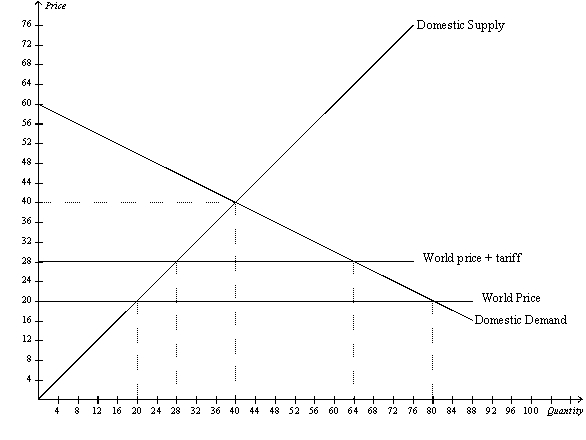 -Refer to Figure 9-17. The deadweight loss caused by the tariff is
-Refer to Figure 9-17. The deadweight loss caused by the tariff is
A) $24.
B) $72.
C) $96.
D) $144.
F) B) and D)
Correct Answer

verified
Correct Answer
verified
Multiple Choice
When, in our analysis of the gains and losses from international trade, we assume that a particular country is small, we are
A) assuming the domestic price before trade will continue to prevail once that country is opened up to trade with other countries.
B) assuming there is no demand for that country's domestically-produced goods by other countries.
C) assuming international trade can benefit producers, but not consumers, in that country.
D) making an assumption that is not necessary to analyze the gains and losses from international trade.
F) B) and C)
Correct Answer

verified
Correct Answer
verified
Multiple Choice
When a country allows international trade and becomes an exporter of a good,
A) domestic producers of the good become better off.
B) domestic consumers of the good become worse off.
C) the gains of the winners exceed the losses of the losers.
D) All of the above are correct.
F) A) and C)
Correct Answer

verified
Correct Answer
verified
Multiple Choice
Trade enhances the economic well-being of a nation in the sense that
A) both domestic producers and domestic consumers of a good become better off with trade, regardless of whether the nation imports or exports the good in question.
B) the gains of domestic producers of a good exceed the losses of domestic consumers of a good, regardless of whether the nation imports or exports the good in question.
C) trade results in an increase in total surplus.
D) trade puts downward pressure on the prices of all goods.
F) None of the above
Correct Answer

verified
Correct Answer
verified
True/False
The nation of Loneland does not allow international trade. In Loneland, you can buy 1 pound of beef for 2 pounds of cheese. In neighboring countries, you can buy 2 pounds of beef for 3 pounds of cheese. If Loneland were to allow free trade, it would export cheese.
B) False
Correct Answer

verified
Correct Answer
verified
Showing 221 - 240 of 409
Related Exams